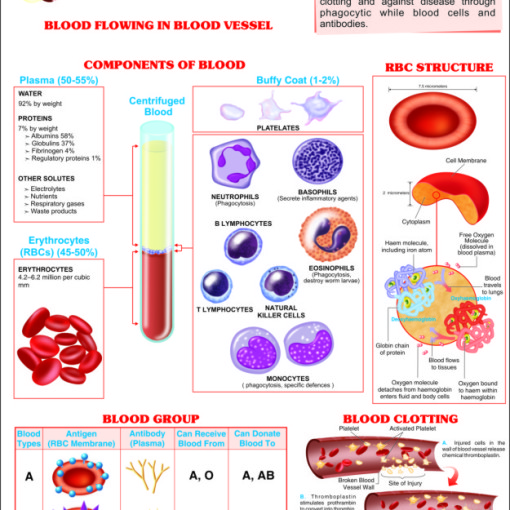Composition of Blood and MCQs For NEET, GPAT, Pharmacist and Staff Nurse Exam
Function of Blood
Composition of Blood
Blood has two components- blood plasma and formed elements. Blood plasma is a watery liquid extracellular matrix that contains dissolved substances. While the formed elements are the cell and cell fragments. Blood has about 45% formed elements and 55% blood plasma. A thin layer between the RBCs and the blood plasma is known as buffy coat.
Above chart is taken from hemcmedical.com for educational purpose only
Blood Plasma
The blood plasma has about 91.5% water and 8.5% solutes. Most of the solutes in blood plasma are proteins. The components of blood plasma are-
- Water:– It is the liquid part of the blood; acts as a solvents and suspending medium for the components of blood.
- Proteins:- about 7% of blood plasma are proteins. they exert colloid osmotic pressure which helps maintain the water balance between blood and tissue. The proteins present are 1. albumins– produced by liver and transports proteins for several steroid hormones. 2. Globulins– produced by liver and work for immune system. 3. Fibrinogen– produced by liver and helps in blood clotting.
- Other substances;- these are about 1.5% of blood plasma. these include electrolytes, nutrients, gases, regulatory substances and waste products.
Formed elements
the formed elements include 3 basic components- red blood cells(RBCs), white blood cells( WBCs) and platelets. RBCs and WBCs are the whole cells while the platelets are the cell fragments. We will study a
1. Red Blood Cells:- These are biconcave disc of diameter 7-8 micro meters. Their plasma membrane is strong and flexible as they pass through narrow capillaries. Glycolipids are present in the plasma membrane of RBCs which provides antigens of various blood groups. RBCs lack nucleus and other organelles. their cytosol contains hemoglobin molecules. Life span is 120 days.
The main and important function of RBC is to carry oxygen molecules to the tissue and cells. The hemoglobin molecules present in the cytosol of RBC carries the oxygen molecules. The Hb has a protein part known as globin and a non protein pigment known as heme. the globin contains 4 polypeptide chains, two alpha chains and two beta chains and an iron ion in the center of each heme ring. The each iron ion binds with oxygen ion. in this way each Hb molecule carries 4 oxygen molecule.
2. White Blood Cells:- White blood cells have nuclei but no hemoglobin. WBCs are of two types- Granular and Agranular leukocytes. Granular leukocytes have granules in their cytoplasm when stained. while the agranular leukocyte does not show any granules on staining.
Granular leukocyte are of 3 types- neutrophil, basophil and eosinophil. While the agranular leukocytes are of two types- monocytes and lymphocytes.
- Neutrophil:- 10-12 micrometer in diameter, nucleus has 2-5 lobes, cytoplasm has pale lilac granule. function include- destruction of bacteria with lysosomes
- Basophil:- 8-10 micrometer of diameter, nucleus has 2 lobes and cytoplasm has deep blue granules. function is they liberate heparin, serotonin and histamine during allergic conditions.
- Eosinophil:- 10-12 micrometer diameter, 2-3 lobed nucleus, and cytoplasm has red-orange granules. function is that they combat the effect of histamine.
- Lymphocytes:– small lymphocytes have 6- micrometer diameter while the large lymphocytes have 10-14 micro meter diameter. nucleus has round shape and cytoplasm lacks granules. function are they help in antigen-antibody reactions, mediate immune responses etc.
- Monocytes:– 12-20 micrometer in diameter and nucleus is kidney shaped and cytoplasm lacks granules. function include phagocytosis.
Platelets:- they are about 150,000-400,00 per microliter of blood. they have 2-4 micrometer diameter, lives for 5-9 days. they lacks nucleus but they have vesicles. Functions include formation of platelet plug in hemostasis and releases chemicals that promotes vascular spasm and blood clotting.

Multiple choice questions(MCQs)
1. Blood is made up of how many components?
A. 2 B. 3
C. 4 D. 5
2. Which protein is produced by liver?
A. albumin B. globulin
C. fibrinogen D. All of the above
3. Which of the following is involved in immune responses?
A. WBCs B. RBCs
C. platelets D. blood plasma
4. What is the average life span of RBCs?
A. 8-10 days B. 4 months
C. 6 years D. 2 years
5. Which of the following statement is NOT true?
A. RBCs lacks nucleus
B. All the WBCs contains lobes
C. platelets have life span of 5-9 days
D. 90% of blood plasma is water
6. What is the shape of nucleus in monocytes?
A. kidney shaped B. sausage shaped
C. triangular shape D. round shape
7. What is the diameter of basophils?
A. 10-12micrometer B. 8-10 micrometer
C. 12-20micrometer D. 6-9 micrometer
8. Match the following functions with its cells-
A. basophils 1. phagocytosis
B. eosinophils 2. Help in antigen-antibody reactions
C. lymphocytes 3. Combat the effect of histamine
D. monocytes 4. Liberate serotonin
9. What is the main function of RBCs?
A. immune surveillance B. produces histamines
C. platelet plug formation D. none of the above
10. What is the main function of neutrophil?
A. liberate heparin B. it has opposite effect to histamine
C. destroys bacteria with lymphocytes D. blood clotting
ANSWERS:–
- 2
- all of the above
- WBCs
- 4 months
- all the WBCs contains lobes
- kidney shaped
- 8-10 micrometer
- A – 4 B – 3 C – 2 D – 1
- none of the above
- destroys bacteria with lymphocytes
List of Successful GPATINDIAN CANDIDATES
Participate in Online FREE GPAT TEST: CLICK HERE
Participate in Online FREE Pharmacist TEST: CLICK HERE
Participate in Online FREE Drug Inspector TEST: CLICK HERE
Participate in CSIR NET JRF Mock Test
REFERENCE:- Gerard J. Tortora -Principles of anatomy and physiology; edition twelfth ; page no.-:691-702 .
